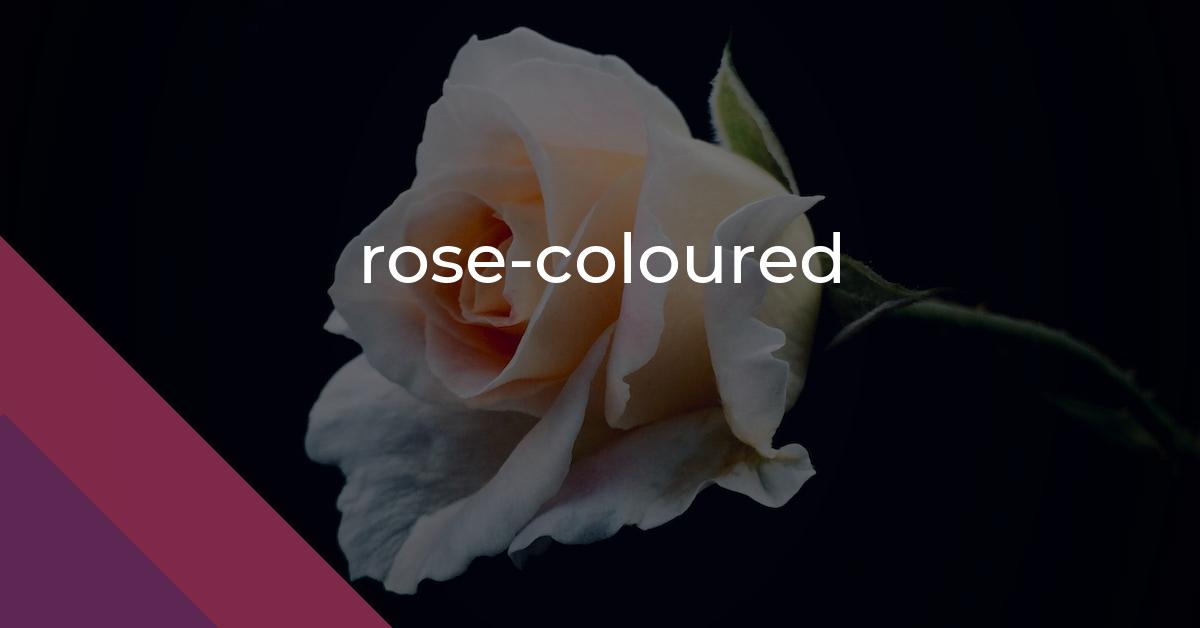rose-coloured: Idiom Meaning and Origin
What does ‘rose-coloured’ mean?
The idiom rose-coloured refers to a positive and overly optimistic perspective or view on a situation or topic, ignoring any negative aspects or realities.

Idiom Explorer
The idiom "see yellow" means to become angry or irritable, often due to a frustrating or annoying situation.
The idiom "see things" means to perceive or experience something in a particular way, often different from reality. It implies a subjective understanding or interpretation of a situation or event.
The idiom "rose-tint" refers to viewing or perceiving something in an overly optimistic or idealistic manner.
The idiom "rose garden" metaphorically refers to a situation or place that appears pleasant and peaceful, but is, in reality, filled with hidden dangers or difficulties.
The idiom "rose-colored glasses" refers to a positive and optimistic perspective or viewpoint.
The idiom "ray of light" refers to a small sign of hope or positivity in a difficult or dark situation. It symbolizes optimism and the belief that things will improve, even in challenging times.
The idiom "raise someone's spirits" means to make someone feel happier or more optimistic.
Decoding Illusion
Rose-coloured is an idiom commonly used to describe an overly optimistic or idealistic outlook or perspective. It originated from the use of rose-tinted glass lenses in the 19th century, which created a soft, warm, and romantic hue. The idiom conveys the idea of seeing things in a more positive light than they may actually be. It can be used both literally, to describe objects or experiences with a pink or reddish color, and metaphorically, to describe an optimistic viewpoint.
When someone is said to be looking at the world through rose-colored glasses, it means they have a positive or optimistic view of a situation or experience, often to the point of being unrealistically so. This idiom suggests that the person is seeing things in the best possible light, ignoring any potential flaws or difficulties. It is a reminder that optimism can sometimes blind us to the less pleasant aspects of reality.
In popular culture, the idiom is often used to describe individuals who maintain an unwaveringly optimistic outlook, even in the face of negative or challenging circumstances. It highlights the tendency of some people to always see the good in a situation, even when others may perceive it as bleak or unfavorable. This idiom serves as a cautionary reminder that positivity should be balanced with a realistic assessment of the situation.
The origin of the rose-colored idiom can be traced back to the 19th century, when rose-tinted glass lenses became popular. These lenses were designed to create a more pleasing and aesthetically pleasing view, as the pink or reddish hue softened the appearance of the surroundings, creating a more romantic atmosphere. Over time, the term "rose-colored" began to be used metaphorically to represent an overly optimistic or idealistic perspective.
Although the idiom has its roots in the visual sense, it is now primarily used in a figurative sense. It is employed in conversations, literature, and media to criticize individuals or situations that exhibit an excessive or unrealistic level of optimism. It reminds us that while optimism can be beneficial, it is important to also acknowledge and address the challenges and shortcomings that may exist.
Alongside the idiom "rose-colored glasses," there are related idioms that capture different aspects of the same concept. "Rose-tint" is used to describe a similar overly optimistic perspective, emphasizing the idea of seeing things through a rosy lens. This idiom reinforces the notion that the person is perceiving the world in a more positive light than might be warranted.
Another related idiom is "paint a rosy picture." This phrase is often used to describe the act of portraying a situation or outcome in an overly optimistic manner. It suggests that someone is presenting a view that is not entirely grounded in reality, choosing to highlight only the positive aspects and downplaying any potential negative consequences.
These related idioms further emphasize the concept of viewing the world through rose-colored glasses, capturing different shades of optimism and idealism. They all serve as reminders to approach situations with a balanced perspective, acknowledging both the positive and negative aspects and understanding that excessive optimism can sometimes cloud our judgment.
The idiom "rose-colored" encapsulates the idea of an overly optimistic or idealistic outlook. Its origins in the use of rose-tinted glasses add depth and significance to its usage. Though sometimes used to criticize unwarranted positivity, it also serves as a reminder of the power of optimism in shaping our view of the world. It is a phrase that invites us to reflect on the balance between optimism and realism in our lives and the importance of seeing things as they truly are.
Example usage
Examples of how the idiom "rose-coloured" can be used in a sentence:
- She always sees the world through rose-coloured glasses, and is often disappointed when reality falls short of her expectations.
- Despite facing numerous obstacles, he continues to paint a rose-coloured picture of his success, refusing to acknowledge the challenges he has encountered.
- They have a rose-coloured view of their relationship, believing it to be perfect despite its many flaws and issues.
More "Perspective" idioms



